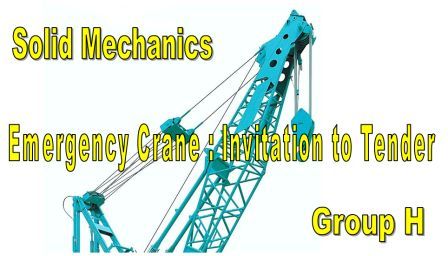We have come to the conclusion as a group that our crane will either have to be made up of Aluminium or Steel whilst taking into account their respective weight, cost, and durability in the long run.
Similarities
To start with the similarities of aluminium and steel:
- Structural applications of aluminium and steel are mostly similar;
- Design problems/processes are similar so an identical approach is used;
- The design rules for aluminium and steel (EC9 and EC3) are purposely very similar, see the first two reasons.
Differences
However, there are important differences in physical as well as mechanical properties which have to be accounted for in the design process. The table on this page gives a comparison between the most important physical properties of aluminium and steel. The differences in properties, the consequences for structural behaviour and how to deal with that in structural design will be elucidated below.
First of all, the low density of aluminium is the main driver for using it in many structural applications. The high strength to weight ratio is the number one reason for the development of the aircraft industry. Although its low weight is a favourable property, it can in some cases be a disadvantage; for example with cyclic loading the ratio live load/dead load is disadvantageous as compared to steel and so fatigue must be considered early in the design stage.
The low density makes an aluminium structure prone to vibrations and in these cases the dynamic behaviour of the structure has to be considered. The Young modulus, E is important for the structural behaviour. Its value is about 1/3 that of steel, but contrary to density, this is a disadvantage compared to steel.
The low value of the Young modulus, E has a big influence on the deformations of an aluminium structure. A well-known example is the bending of beams, where the stiffness EI is the governing factor and IAl = 3 ISteel to arrive at the same stiffness as a steel beam which is illustrated in the table below.
The above indicates that in designing aluminium structures, it is often not the strength, but in many cases the deformation, that is the governing factor. So in building and civil engineering it is frequently the alloy which does not have the highest strength that has to be considered.
The low Young modulus is also responsible for the higher sensitivity to stability problems in aluminium structures (buckling). The critical stress for buckling is linearly related to the Young modulus. Moreover, aluminium designs often have very slender, thin walled sections which make it even more important to consider their stability in designing structures.
Finally, there is cyclic loading, where the Young modulus is responsible for the lower fatigue strength of aluminium – circa half that of steel. This, in combination with the low density, means that fatigue design should be considered more carefully than with steel structures. Similar to the Young modulus is the shear modulus G which is also about 1/3 of that for steel. This means that the resistance against shear forces, shear deformations and shear stability (for example lateral torsional buckling of beams) can be an important aspect in the design.



Do not copy and paste from the web !
ReplyDelete